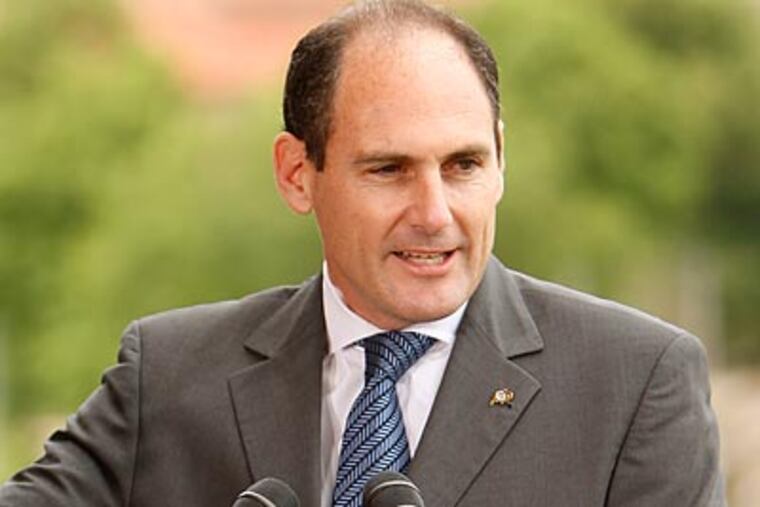John Smallwood: Pac-10 Conference fumbled in its bid to expand
THE THING ABOUT the latest shakeup in college sports is that the conference that initiated it - the Pacific 10 - wound up being the biggest loser.

THE THING ABOUT the latest shakeup in college sports is that the conference that initiated it - the Pacific 10 - wound up being the biggest loser.
Just 10 days ago, the Pac-10 appeared to have positioned itself to become the first "super conference."
It was going to sweep through the Big 12, swipe heavy-hitting schools like Texas, Oklahoma, Texas A & M, Texas Tech and Oklahoma State and pass the Southeastern Conference and the Big Ten as the power broker in collegiate athletics.
The opposite of Teddy Roosevelt, though: The Pac-10 talked loudly but carried a twig.
Sure, the Pac-10 caused a little anxiety, especially in the southwestern and midwestern portions of the country, but what it accomplished in the end barely caused a ripple.
The Pac-10 reached for the stars and came away with the University of Colorado and the University of Utah.
Maybe it's me, but when you're talking Texas, Oklahoma, Texas A & M, Texas Tech and Oklahoma State to form a 16-team super conference, ending up with Colorado and Utah can't even be considered a moral victory. In fact, the chain reaction it started did more to help the Big Ten and surviving members of the Big 12 than it did to help the Pac-10 itself.
The Big Ten-plus-one finally got back to an even number when Nebraska, fearing the implosion of the Big 12, joined. Adding a traditional football power to a conference that already includes historical powers Penn State, Ohio State and Michigan could be enough to finally get the Big Ten to stop its one-sided love affair with Notre Dame.
Despite losing Nebraska and Colorado, the now 10-member Big 12 (maybe there should be a name swap), might actually be stronger.
Nebraska is still trying to work its way back to super-elite status in football and it has never been more than a role player in basketball, the other big revenue sport in collegiate athletics. The same can be said about Colorado, except its tradition in football is not nearly as established.
As long as Texas and Oklahoma stayed, the Big 12 lost little luster.
And while much of this has been about football, don't forget how important Kansas is as a basketball program.
A Big 12 with Kansas, Texas and Oklahoma is as strong at the top as any basketball conference. And programs with histories of success like Oklahoma State, Missouri, Kansas State and Iowa State keep it competitive, top to bottom.
In basketball, the Big 12 actually rid itself of the two mutts of the conference.
And the Pac-10 takes a serious hit in credibility. The only one who might have swung harder and whiffed was "Mighty Casey."
The conference might rattle a saber about putting the college athletic world on notice, but if you're going to attempt a coup of this level, you get egg on your face when it falls apart.
If the scenarios reported are correct, the Pac-10 got done in when Kansas, Kansas State, Iowa State, Baylor and Missouri - the five lightweights that nobody wanted - drew up a business plan that made it more lucrative for the three heavyweight schools - Texas, Texas A & M and Oklahoma - to stick with them.
Basically, that means the power schools of the West Coast got kicked in the butts by five schools from Middle America.
I don't see how the Pac-10 comes out looking stronger and more fearsome. This is about money, particularly increased revenues in television rights.
The Pac-10 made this attempt because it figured that with the Texas schools, Colorado and Oklahoma, it would add television markets that would allow it to close the fees gap that is about four times less than what the Big Ten and Southeastern Conference get.
With Colorado, the Pac-10 adds the Denver market, which is the 18th largest, but it already had the second (Los Angeles), sixth (San Francisco/Oakland/San Jose), 12th (Phoenix), 14th (Seattle/Tacoma), 20th (Sacramento/Stockton/Modesto) and 22nd (Portland, Ore.).
That tells you everything.
The SEC has just two schools, Florida and Georgia, that can be geographically linked to a top-25 market; the Gators compete with Atlantic Coast Conference members Florida State and Miami and the Bulldogs with the ACC's Georgia Tech, for attention in those markets.
Still, the SEC trails only the Big Ten in BCS television contract fees.
Florida, Alabama, Tennessee, Georgia, Louisiana State, Kentucky and Auburn are SEC schools with national name recognition in football, basketball or both.
The football program at Southern California and the basketball programs at UCLA and Arizona are the only ones in the Pac-10 that have a true national identity.
The Pac-10's problem is that it is really the Pacific Time Zone Conference.
It's hard to be a "national" conference when most of your games start 3 hours behind New York, Philadelphia, Boston, Atlanta and Washington, D.C., which comprise five of the top nine markets.
The Pac-10 adding Colorado and Utah won't change that.
Send e-mail to
For recent columns, go to